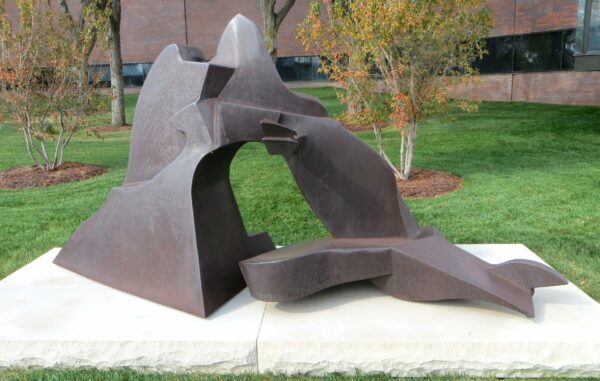
Extended Land Form
Hunt, Richard
1975
Artwork Information
-
Title:
Extended Land Form
-
Artist:
Hunt, Richard
-
Artist Bio:
American, 1935-2023
-
Date:
1975
-
Medium:
Cor-Ten steel
-
Dimensions:
67 1/2 x 144 x 62 inches
-
Credit Line:
Wichita Art Museum, Museum Purchase, Wichita Art Museum Members Foundation, Fourth Financial Center, Mr. and Mrs. Kenneth Brasted, Mr. Harry Litwin and MISCO Charitable Trust, S. O. Beren and Allen Staub Trustees
-
Object Number:
1976.19
-
Display:
Currently on Display
About the Artwork
Richard Hunt is best known for his large-scale public sculpture. Extended Land Form refers to landscape, one of the dominant themes of Hunt’s sculpture. Hunt’s sculpture evolved from the traditions of surrealism and assemblage. Like the surrealists, Hunt uses abstract imagery to visualize the conflicts of idea and emotion, which lie behind actual appearances.
As a young artist, Hunt was most impressed with the work of Spanish surrealist Julio Gonzáles. He adopted Gonzáles’ technique of welding and applied that to the modernist idea of assemblage, that is, making a work of art from pre-fabricated found objects and non-art materials. Hunt constructed his earliest pieces out of discarded machine parts from the junkyard.
As Hunt developed his own style and themes, he retained the look of machinery in his finished sculpture. The artist explains that the experience of seeing abandoned, corroding autos and farm implements in country fields influenced certain of his sculptural designs. He was intrigued by the idea of the metamorphosis of the machine from an industrial geometric structure into an organic construction as the forces of nature gradually worked to decompose and absorb the discarded man-made objects.
Hunt is widely regarded as one of America’s foremost sculptors. Hilton Kramer, author of The Age of the Avant Guard, calls him “one of the most gifted and assured artists working in the direct-metal, open-form medium . . . not only in his own country and generation, but anywhere in the world.”